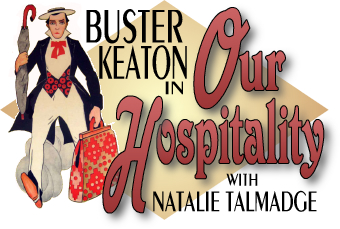

Directed by Buster Keaton and John Blystone
Distributed by Metro Pictures, a Joseph M. Schenck Production
Cast: Buster Keaton (Willie McKay), Natalie Talmadge (the girl,
Joseph Canfield's daughter), Joe Roberts (Joseph Canfield), Ralph
Bushman (Canfield's son), Craig Ward (Canfield's son), Monte Collins
(the Parson), Joe Keaton (the Engineer), Kitty Bradbury (the Aunt),
Edward Coxen (John McKay), Jean Dumas (Mrs. McKay), Buster Keaton
Jr. (Willie as a baby)
"Our Hospitality" is a fine film, filled with ingenious gags, and ranks as one of the best comedy features from the silent era. However, although it's great fun to watch, the depth of the story is no more than one would find in many of Keaton's shorts.
It's a simple construction - Willie McKay is a descendent of a family in Blue Ridge Mountains who carried on a feud for many years with the Canfield family. Having been brought up from a baby in New York after his father was killed in the feud, he returns to the Blue Ridge Mountains to claim the "estate" he has inherited - oblivious to the fact that the Canfields still vow they'll kill any McKay they see. Willie meets a girl on the train and is invited to her house for dinner. Only after being there for some time does he realize she, her father and the two oversized brothers are Canfields. However, as long as he's a guest in the house, they can't shoot him - thus, the title, "Our Hospitality." Of course, much of the humor arises from the father and brothers' attempts to catch Willie outside the house, because - according to their "code" of Southern hospitality - shooting him in the house just wouldn't be hospitable! Outside the house - that's another matter!
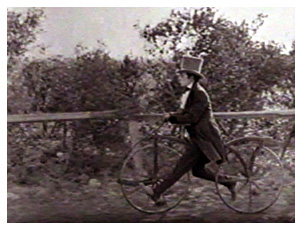 The prologue is more dramatic than
one would expect as a prelude to a comedy, yet it is well done
and necessary to the story. Torrential rains fall outside the
McKays' small cabin in the hills in 1810. John McKay, his wife,
and little baby, Willie, are fearful the Canfields may use the
rain-drenched darkness as a cover to harm them. Over at the Canfield's
"big" house, Jim tells his brother, Joseph, he's going
to kill McKay. Joseph pleads with him to forget the feud. Refusing
to listen, Jim approaches the McKay cabin where he and McKay exchange
gunfire outside. Both are killed. Joseph must now avenge his brother's
death and vows revenge on all McKays. Fearing for her son's safety,
Willie's mother takes him to relatives in New York.
The prologue is more dramatic than
one would expect as a prelude to a comedy, yet it is well done
and necessary to the story. Torrential rains fall outside the
McKays' small cabin in the hills in 1810. John McKay, his wife,
and little baby, Willie, are fearful the Canfields may use the
rain-drenched darkness as a cover to harm them. Over at the Canfield's
"big" house, Jim tells his brother, Joseph, he's going
to kill McKay. Joseph pleads with him to forget the feud. Refusing
to listen, Jim approaches the McKay cabin where he and McKay exchange
gunfire outside. Both are killed. Joseph must now avenge his brother's
death and vows revenge on all McKays. Fearing for her son's safety,
Willie's mother takes him to relatives in New York.
After a somber opening, we leap forward 20 years. Willie, in natty attire, receives a letter from an attorney that he should come to Rockville to claim the McKay "estate." At this point, one would think the next logical scene would be the hazards ahead of him in the Blue Ridge Mountains. Not Keaton. By far the most adept of any of the silent comedians at using props of all kinds to get laughs, a lengthy portion of the film involves the trip - much to the viewer's good fortune. For example, he creates an exact replica of an early bicycle - an object in which Keaton obviously saw humor, and, in his own inimitable way, conveyed that humor to us. Because the bicycle has no pedals, it's operation is dependent on the rider sitting and pushing himself along with both feet. Who other than Keaton could get a laugh from this simple act?
Where Keaton gets some of the biggest laughs in the film - and obviously enjoys himself immensely - is with the early train which reminds one of a string of stagecoaches being pulled by a small steam engine that doesn't even have a "cab" for the engineer - he just stands proudly on a small platform behind the engine. The train is actually a replica of an early English train called "Rocket." A good portion of the film is dedicated to the ride on the Rocket from New York to Kentucky - and it's a ride replete with gags.
For example, Willie sits nervously next to the girl on the train (remember, the "cars" look like miniature stagecoaches) - very tight quarters and no headroom. However, he is determined to put his very large, early 1800's, Victorian top hat back on. He tries, but there isn't enough room above his head. He had an idea. Slouching down in the seat, he makes enough room above his head to place the hat flush against the roof, then lifts himself up until his head rises into the hat. Seems to be a neat solution - that is, until they hit a bump. The hat jams against the roof, and Willie is pushed up into the hat until it's down below his nose. Keaton was not above stepping out of the "play" for a moment which he does here. After prying the hat loose from his head, he's frustrated that there isn't enough room for the tall hat in the cramped space he has. He lifts his carpetbag from the floor, rummages through it for a moment, and then we see the trademark porkpie hat come out which he places satisfactorily on his head - at last, he's back in his comfort zone! The hat was brought into play again in "Steamboat Bill, Jr." (1928) when he was trying on a variety of hats in the store. A seemingly unending series of hats are placed on his head, but when he looks in the mirror and notices that the porkpie hat has been placed on his head, he jerks it off quickly. The hat wasn't necessary or appropriate for some of his feature films, but it was just as much Keaton as the cane and derby were Chaplin.
Another gag involves a mountaineer who throws rocks at the engine as it slowly ambles by. The engineer, in return, throws wood from his tender back at the man. After the train passes, the mountaineer scurries around gathering up the wood. Obviously, his rock-throwing was a ploy to get some free firewood. One can't help but wonder what kind of mind came up with this gag? It's hilarious!
The further they go in to the mountains, too, the little train has more and more rough terrain to negotiate. We see it become progressively bumpier - all in believable fashion, and then, in an almost surreal moment, we see the track laid across a fallen tree - now why wouldn't they have just removed it from the path of the tracks? Not in a Keaton film! Instead, the train follows the tracks right over it! Describing the trip on the Rocket down South, Keaton said, "And they're narrow gauge, and they weren't so fussy about layin' railroad track . . . if it was a little unlevel, they just ignored it. They laid it over fallen trees, over rocks . . . So I got quite a few laughs ridin' that railroad." 1
Biographer Tom Dardis described the uniqueness of this sequence. "The long trip southward on the Rocket is an extended sequence with a wonderful dreamlike, idyllic quality to it that has few parallels in film." (1)
By the way, there is one bit that will be found later in
Keaton's "The General" (1927). Part of the train accidentally
becomes unhooked from the engine and tender. Someone turns the
switch and, as 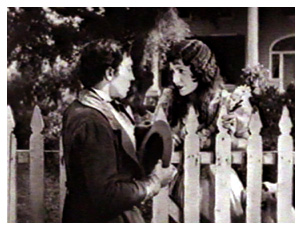 the engine and tender go straight,
the coaches go off on a side track. The coaches move along faster
than the engine and end up coming back onto the main track at
the next switch - ahead of the engine! The engineer, who has maintained
his proud stance as he takes in the scenery, suddenly turns to
see his train missing. What a surprise when he finds the coaches
have somehow found their way in front of him!
the engine and tender go straight,
the coaches go off on a side track. The coaches move along faster
than the engine and end up coming back onto the main track at
the next switch - ahead of the engine! The engineer, who has maintained
his proud stance as he takes in the scenery, suddenly turns to
see his train missing. What a surprise when he finds the coaches
have somehow found their way in front of him!
Keaton liked to keep his character clueless to the situation and danger around him. Of course, we know he's in danger, and therein lies some of the enjoyment for the viewer. This provided Keaton a natural basis for humorous "bits" as his character always seemed to emerge from the danger unscathed, but only through dumb luck - not any conscious action on his part. For example, after getting off the train, he begins looking for his "estate" and happens to be walking with one of the Canfield boys. Initially, neither is aware of the other's true identify. Yet, during the course of the conversation, the Canfield son learns he's walking with a McKay, and, as (bad) luck would have it - he doesn't have a gun handy. So, as they proceed along the street, he asks Willie to stop and wait a minute while he runs inside a business or house to find a gun - each time with no success. When he finally does find a gun, he comes outside and finds Willie gone. Where was Willie? While the Canfield son was inside, Willie sees a husband and wife emerge from their house, a horrendous display with the husband beating the wife. Chivalrously, he intervenes. Of course, Keaton was the master of the unexpected, and, surprisingly, the wife begins to beat on Willie for interfering. He runs to get away from her. Of course, when the Canfield son emerges with the gun, Willie is nowhere in sight. Once again, dumb luck has rescued him by removing him from the danger.
A significant portion of the film takes place in the Canfield house and centers around the boys' impatience to catch Willie outside the house so they can kill him without violating their "code" of hospitality. At first, Willie is unaware of what it taking place. However, once he realizes the situation and how the "code" works, he does all he can to avoid being caught outside - even managing to stay overnight due to a storm that has come up. The next day, when Willie finally decides to escape, he dresses as a woman, and walks away as one of the Canfield boys watches. He would have succeeded; however, the dress is raised to reveal his pants . . . and the chase is on!
An excellent gag follows as a result of this. It appears the boys have finally found Willie walking across a field - still wearing the dress and carrying the open parasol over his shoulder. Just as they take aim, we see the dress turn to reveal a horse! Willie had attached the dress and umbrella to the rear of the horse. What is so amazing is that the movement of the dress as we saw it earlier looked exactly as if someone was walking - almost with a feminine "swing" of the hips. The gag is flawless!
Following an exciting chase across a mountainside in which
Willie falls from an incredible height into the river below, he
comes upon the train and steals the engine and tender. In a scene
once again reminiscent of "The General," he is getting
wood from the tender to the engine - straddling the space between
the two cars. They unhook, and, barely avoiding a plunge into
the increasing open space as his legs are stretched to the limit
(a very dangerous stunt), he finally grabs the tender and jumps
in with the wood. The tender then runs off the track and overturns
into the river. Suddenly, Willie 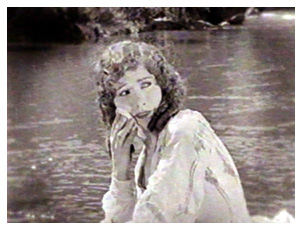 pops
up sitting in a wooden box loaded with wood and paddling down
the river - smoothly transferring from one mode of transportation
to the other - totally unruffled as if this were planned all along.
pops
up sitting in a wooden box loaded with wood and paddling down
the river - smoothly transferring from one mode of transportation
to the other - totally unruffled as if this were planned all along.
Saving the best and most exciting for last, this leads to the climax of the film where Willie must save the girl. A series of incidents now have Willie on a rock ledge at the waterfall trying to untie a rope around his waist that is also caught on a log - and the only reason the log isn't flowing over the waterfall is because one of its cut off limbs is caught on a crevice on the rock wall. At the same time, the girl has fallen in the river and is being swept helplessly toward the waterfall. Willie appears to be helpless unless he can unloose himself from the rope - and time is running out - a situation that would make D.W. Griffith proud! Much is going on here to cause excitement - not only are we unsure how he'll save the girl - the log may unloose itself at any minute and take Willie over the edge if he can't untie the knot around his waist. (For a detailed description of how the rescue happened, see "Keaton's All Wet" on our "Articles and Essays" page.
The making of the film was not without its troubles. Keaton almost drowned during the rescue sequence in the Truckee River (Lake Tahoe). The danger occurred when the wire attached to him broke. He was swept down the river and almost dashed against the rocks. He was fortunately able to grab an overhanging branch and save himself.
Big Joe Roberts suffered a stroke while on location; however, he was able to continue work on the film in a weakened condition. Sadly, he would pass away a short time later. "Our Hospitality" was his last film.
The film was a family affair. Keaton's first child, Jimmy,
(billed as Buster Keaton, Jr.) is the baby in the film's prologue.
His father played the engineer on the train, and, of course, wife
Natalie was the leading lady. Natalie became pregnant with their
second son during production, and shooting had to be adjusted
to avoid revealing her pregnancy.
"Despite all the difficulties, Buster remembered the production
fondly," said Eleanor Keaton (Keaton's widow) and biographer
Jeffrey Vance. "The summer stay in Tahoe with his family
reminded him of his happy boyhood summers spent on Lake Muskegon,
Michigan. Buster was proud of 'Our Hospitality' (he always referred
to the film as simply 'Hospitality') and considered it one of
his best films." (4)
And the film did enjoy great success. Biographer Tom Dardis said,
"'Our Hospitality' was a big box office success. Metro promoted
the picture heavily, taking a full four-page ad in Moving Picture
World." (1) According to Keaton, "Working with my own
unit on my own lot I made several successful ones. The first of
these Metro releases was 'The Three Ages,' the second 'Our Hospitality.'
As I mentioned, most of my features cost from $200,000 to $220,000
to produce and grossed in rentals $1,000,000 upward. The enormous
profits justified our spending that much on production, 20 to
30 percent more than the average dramatic feature then cost to
make." He continued, "In its first week at the Capitol,
Loew's big Broadway presentation house, it equaled the box-office
record, and in Loew's Circuit's hundreds of theatres, it nearly
tied the box-office record for the chain." (2)
Revered silent film historian William K. Everson called
it, "one of Keaton's most charming and funny comedies."
(3) Eleanor Keaton and Jeffrey Vance said, "'Our Hospitality'
is one of Buster's 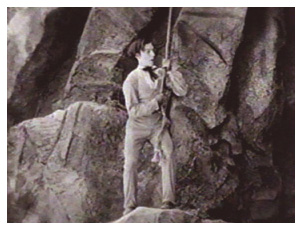 most perfectly constructed
films." (4)
most perfectly constructed
films." (4)
Harrison's Reports praised the film saying, "This
comedy-drama excels primarily because of its fascinating originality;
not a foot of it is commonplace." (5) According to The
New York Times, "It starts rather slowly, but gathers
speed with a vengeance toward the last reel. Mr. Keaton has evolved,
and evidently kept secret, many new comical ideas which will undoubtedly
cause the Rialto to echo and re-echo with roars of laughter while
the film is filling the screen." The reviewer went on to
say, "This funny film moves along quietly at the outset,
but in the end it gets there, and to our mind, it is a mixture
that is extremely pleasing, as there is no out-and-out slapstick
effect. Natalie Talmadge is quite good in her part, and the rest
of the cast are excellent support for the man who never seems
to change his expression, let alone crack a smile." (6)
All of Keaton's silent features are gems, and it is appropriate
that this feature - "Our Hospitality" - is the most
recent among a series of Keaton features released on "Blu-Ray"
by Kino International, thus assuring the finest possible quality
for viewers today.
Sources:
1 Dardis, Tom. Keaton, the Man Who Wouldn't Lie Down (New York: Charles Scribner and Sons, 1979).
2 Keaton, Buster. My Wonderful World of Slapstick (New York: De Capo Press, 1982).
3 Everson, William K. American Silent Film (New York: Da Capo Press, 1998).
4 Keaton, Eleanor, and Jeffrey Vance. Buster Keaton Remembered (New York: Harry N. Abrams, Inc., Publishers, 2001).
5 "Our Hospitality," Harrison's Reports November 17, 1923.
6 "Hospitality," The New York Times December 10,
1923.
Copyright 2011 by Tim Lussier. All rights reserved.